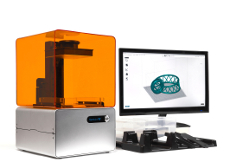The 3D printing industry is moving in very mysterious ways. As new entrants deliver more cost effective and capable tech, Al Dean looks at how the older vendors are reacting and wonders if a little history lesson might be in order…
As I think we’ve now established, the 3D printing industry has changed forever. While it was once the preserve of professional users as an aid to product development, awareness has now grown to the point where the tech-savvy public are cottoning on.
Fuelled by a rapidly growing market of entry-level, affordable 3D printers, more and more people are now engaging with it.

But consumer-level 3D printing has moved beyond the RepRap clones. We’re now seeing affordable 3D printers that are much more sophisticated than those that feature entrylevel Fused Deposition Modelling (FDM), the process that melts and deposits ABS plastic.
In a few months’ time for just over $2,000 you’ll be able to buy a 3D printer that can either build to the fidelity of an Stereolithography (SLA) system, or make FDM parts in a sizeable build envelope.
But these new machines aren’t just for consumers. FormLabs’ Form 1 and the new MakerBot Replicator 2 are both targeting professional users.
And from the excitement both have caused, the market seems to be responding. Orders are being placed, businesses are being expanded. These are exciting times.
The new kids on the block
MakerBot’s Replicator 2 ($2,199) is more slick than the original machine, offers a larger build volume (that rivals significantly more expensive machines), boasts a higher print resolution and looks the business.
The FormLabs Form 1 ($2,299 on kickstarter.com) is a completely different animal. It’s an amalgamation of an SLA process and some of the build methods found in Envisiontec machines (using capiliiary action in an inverted build chamber to feed material).
The technology looks great and the unit is just as impressively styled.
Boasting impressive build speed, build volume and fidelity, on paper both machines look like a very exciting proposition for entrylevel professional use. And the best thing about them — they’re low cost, both in terms of initial outlay and ongoing running costs.
This new low-cost professional 3D printing movement has been brewing for some time and the established 3D printer manufacturers are reacting, but are they doing enough?
The truly low-cost products, such as the 3D Systems Cube ($1,299), are really only targeted at consumers; entry-level professional machines, such as the Stratasys Mojo ($9,900), remain comparitively expensive.
And like the highend machines from which they evolved, many are plagued by high on-going materials and consumables costs.
It could have been different
From a technology perspective, there’s nothing particuarly groundbreaking about the MakerBot Replicator 2 and FormLabs Form 1.
Both machines could easily have been developed by the traditional 3D printing manufacturers.
The revolution is coming from the new entrants, offering similar technology and capability for dramatically lower costs
They’ve got more than enough technology and knowledge in house and by setting a price that’s within reach of most designers and engineers, could have produced a truly compelling 3D print solution with mass market appeal.
Instead there appears to be an element of protectionism — an old guard too scared to cannibalise the sales of their mid to high-end machines.
The problem is, 3D printing has been highly conservative for a long time. Prices have incremented down over the years, and even though prices have fallen recently, there’s been nothing to truly shake things up.
Instead, the revolution now appears to be coming from the new entrants, offering similar technology and capability for dramatically lower costs.
The cycle of life
For long time followers of the CAD industry, this might sound all too familiar. It should. It’s exactly what happened two decades ago in 3D design software.
The high-end CAD software developers didn’t see it coming. SolidWorks took an existing idea (feature-based, parametric modelling) delivered it on more affordable hardware at lower cost and built its business around a community.
The traditional players struggled to keep up. Some released cut-down, hacked up versions of existing tools (anyone remember Pro/Junior?). Or they tried to acquire their way out of the problem by merging user bases. And in many respects they’re still playing catch up.
The 3D printing market looks to be going through a similar transition, from a high-end niche to a mass market. And if the traditional 3D printing firms don’t watch out they’ll be in danger of being left behind.






